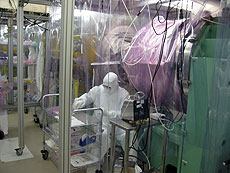| Friday, April 2, 2010 |
| Subscribe | Contact Fermilab Today | Archive | Classifieds |
AD & TD collaborate on first cryomodule for new facilityIt is perhaps fitting that the New Muon Lab, a long, low concrete affair facing open fields, sits facing the northern edge of Fermilab's property. The hangar-sized building is a busy place these days, home to the laboratory's Superconducting Radio Frequency Test Facility, and bustling with the work that keeps Fermilab pushing the boundary of high-energy particle physics research. Crews from the laboratory's Accelerator Division and Technical Division recently wrapped up a month-long collaboration at NML on a beamline vacuum system for the facility's first cryomodule, the technology for future particle accelerators such as Project X and the ILC. Hidden inside a labyrinthine series of concrete walls six feet thick, the hulking, marigold-yellow tube holds eight SRF cavities-the mechanisms that accelerate particle beams to powerful energies. To do the job, those cavities must be scrupulously clean. A simple dust speck can spell disaster. Accelerator Division's Jerry Leibfritz, the SRF Test Facility project leader, said that presented a serious challenge for the technicians installing the cavity string vacuum system. "Every connection-every last nut and bolt-had to be cleaned with a pure-nitrogen air gun until it was particulate free," he said. The laboratory had to build portable clean rooms around the cryomodule. It took five men a full four weeks, regularly working overtime and weekends, to get the vacuum system in place. Leibfritz rapped a knuckle against a locked, transparent case surrounding the vacuum system's few exposed valves and piping. Made from the same material as bullet-proof glass, he said, the box is practically indestructible. It's there to protect the SRF cavities from accidental exposure-whether from a dropped wrench or well-intentioned fiddling by technicians. "If anything got inside the cavities, years of work and incredibly expensive technology would be ruined," he said. Technical Division's Tug Arkan appreciates such vigilance. Arkan, along with colleagues from Germany's DESY laboratory, oversaw the assembly of the SRF cavities at Fermilab, and said that, so far, it looks like everyone's efforts have paid off. "The initial quality assessment is good," he said. "You can't achieve such a strong vacuum so quickly in the beamline after the installation if the cavities aren't clean." Steve Holmes, Associate Director for Accelerators, said each division brought crucial skills to the project-Technical Division has the clean-room experts, and Accelerator Division has the high-vacuum experts. "Cooperation is really a critical element of success in this area," he said. "Neither division had the wherewithal to do this on its own." This first cryomodule is one of six that will eventually go into the NML Accelerator Test Facility, which, Leibfritz said, will essentially be a mini ILC. "It's a whole new technology for Fermilab," Leibfritz said. "And it's the future." -- Andrea Mustain |
